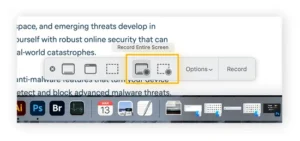Blog
How To Screen Record On IPhone in 2024…? Best 2 ways to record

Screen Record On iPhone
The control center of the iPhone contains many buttons to easily access apps and abilities across the device including screen recording, and how users can screen record on iPhone.
- Some of the latest devices may automatically come with a control center that easily enables screen record on iPhone from settings, users who do not have it in their devices add them via the iPhone setting.
- The option of screen record on iPhone is added to the control center, the user can start the screen recording from the control center.
- Screen recording automatically saves the photos if you have storage on your device.
Enable screen record on iPhone from the control center :

To enable screen recording, go to Settings, Content, and Privacy, select Content Restrictions, click Screen Recording, and choose Allow. To add Screen recording to the control center on an iPhone, go to settings, Go visit the Control center, Enable accessibility within apps, and select circled, green plus sign next to screen recording. From there, users will be able to go directly to the Control Center accessible by gently sliding down the top-right corner of the iPhone and recording the screen by clicking the screen recording icon.
How to Screen Record on iPhone:

To screen recording on iPhone, go to the control center and select the screen recording icon. Users have three seconds before recording, indicated by a highlighted and blinking recording symbol. Users should click the same icon to stop the screen recording. To make sure the screen recording picks up sound from the screen, turn on the iPhone ringer. To add voice-over to a screen recording, enable the microphone by pressing down on the screen recording icon, and selecting it after the microphone icon appears.
Editing the Screen Recording :

The Screen Recording is go to the photos library and go to the Screen Recording icon in the control center to ensure that Photos are selected as the destination for the Screen Recording. There are many third-party applications to edit the screen recording, the iPhone also edits the screen recording as well.
Best 5 screen recording apps for iPhone
- iOS Screen Recorder: This is built into the iPhone’s operating system. Simply swipe down from the upper-right corner of the screen to open Control Center, then tap the Screen Recording icon to start recording.
- TechSmith Capture: Formerly known as Jing, TechSmith Capture allows you to capture video from your screen, add narration, and easily share your recordings.
- DU Recorder: DU Recorder is a versatile screen recording app that offers high-quality video recording, screen capture, and video editing features. It’s popular for its simplicity and comprehensive feature set.
- AirShou: AirShou is another popular choice for screen recording on iPhone. It provides smooth recording with high-quality output and offers features like adding audio commentary while recording.
- Record it!: Record it! is a user-friendly screen recording app that allows you to capture your screen with just a few taps. It offers features like video editing, adding text and stickers, and sharing directly to social media platforms.
Related to: How to Set Timer on the iPhone Camera
How to Screen Record on Mac
Here’s how to enable screen recording on our Mac:
- Tap ⌘ the (Command) key Shift + 5 simultaneously to extend the Screenshot toolbar.
- Choose either Record Entire Screen (the 4th icon on it), or Record Selected Portion (the 5th icon) on the toolbar. We can glide over the icons to see what they do.
- If we like to record a typical portion of our screen, choose Record Selected Portion (the 5th icon) and highlight the area we like to record.
- Press on Record.

Our full Mac screen, or the portion of our Mac we highlighted, will directly record video. Press the stop icon in the menu bar to finish the screen recording. We can also TAP ⌘ (Command) + Control + Escape to finish screen recording on Mac, or hit Escape BUTTON to cancel our Mac screen recording before it begins.
Below, we’ll also display how to record our screen with Voice on Mac.
How to enable the record screen option with audio on our Mac
By default, Macs record without sound, but they do have an alternative for screen recording with Mp3.
Here’s how to record our screen and Voice at the same time on Mac:
- Extend the Screenshot Toolbar or open QuickTime Player > File > New Screen Recording.
- Press Options, then choose our best microphone for the audio recording.
- Select either Record Full Screen or Record Selected Portion.
- Tap Record.
- Extend the Screenshot Toolbar or open QuickTime Player > File > New Screen Recording.
- Press Options, then choose our best microphone for the audio recording.
- Select either Record Full Screen or Record Selected Portion.
- Tap Record
Best 5 Screen Recorders software for mac
- ScreenFlow: Renowned for its robust feature set, ScreenFlow is a favorite among content creators and professionals alike. Its intuitive interface allows for easy recording, editing, and sharing of high-quality videos. With advanced editing capabilities like multi-channel audio mixing and support for animations and annotations, ScreenFlow empowers users to produce polished and professional-looking content effortlessly.
- Camtasia: Developed by TechSmith, Camtasia is a powerful screen recording and video editing software that’s perfect for Mac users seeking versatility and ease of use. With its drag-and-drop interface and a wide range of editing tools, including animations, effects, and customizable templates, Camtasia streamlines the video creation process, making it ideal for both beginners and experienced users.
- QuickTime Player: Often overlooked, QuickTime Player comes pre-installed on every Mac and offers basic screen recording functionality that gets the job done without any frills. While lacking advanced editing features, QuickTime Player is a reliable option for quick and straightforward screen recordings, making it suitable for casual users or those on a budget.
- OBS Studio: Short for Open Broadcaster Software, OBS Studio is an open-source screen recording and live streaming software cherished by gamers, educators, and live streamers alike. Despite its slightly steeper learning curve compared to other options, OBS Studio provides unparalleled customization and control over your recordings, allowing you to tailor every aspect of your screen capture to your liking.
- Snagit: If you’re looking for a lightweight yet powerful screen recording solution, look no further than Snagit. Developed by TechSmith, the same company behind Camtasia, Snagit offers a simplified approach to screen capture with features like panoramic scrolling capture and built-in annotation tools. Whether you’re capturing screenshots or recording videos, Snagit excels in providing a seamless and intuitive user experience.
Related to; How to screenshot on mac
Technology
“Power BI vs Tableau: Which Reigns is Best or Supreme in 2024?”

Introduction to Power BI vs Tableau:
In the world of information visualization and analytics, Power BI vs Tableau stand out as two of the most unmistakable gadgets. Each has its qualities and lacks, catering to contrasting needs and inclines. Understanding the contrasts between Power BI and Tableau is pivotal for making an instructed choice about which contraption best suits your necessities.
Background of Power BI and Tableau:
Both Power BI and Tableau have picked up broad ubiquity over a long time, revolutionizing how businesses analyze and visualize information. Control BI, created by Microsoft, entered the showcase in 2013, whereas Scene, established in 2003, has been an overwhelming player for longer. In spite of their varying timelines, both apparatuses have advanced altogether, joining progressed highlights and functionalities.
Purpose and Functionality:
Power BI and Tableau serve the common reason for changing crude information into noteworthy experiences. In any case, they utilize unmistakable approaches to accomplish this objective. Control BI, profoundly coordinates with the Microsoft environment and offers a consistent network with Exceed expectations, SQL Server, and other Microsoft items. On the other hand, Scene gloats a more instinctive and user-friendly interface, making it a favorite among information visualization devotees.
Cost and Licensing Models:
Taken contemplations play a noteworthy part in the decision-making handle for businesses assessing Control BI vs. Scene. Control BI offers a run of estimating alternatives, counting a free form with restricted highlights and subscription-based plans for people and endeavors. The scene, in the meantime, takes after a layered estimating structure, with diverse estimating levels based on the highlights and functionalities required.
Data Connectivity and Integration Capabilities:
The capacity to interface to and coordinated with different information sources is a vital angle of any information analytics apparatus. Control BI and Scene back a wide run of information connectors, empowering clients to get to information from different sources such as databases, cloud administrations, and spreadsheets. In any case, Control BI’s local integration with Microsoft items gives it a competitive edge for organizations intensely contributed in the Microsoft environment.
Visualization Capabilities and Customization Options:
The adequacy of an information visualization device pivots on its capacity to make compelling and quick visualizations. Both Control BI and Scene offer plenty of visualization choices, counting charts, charts, maps, and dashboards. Whereas Control BI gives a strong set of visualization devices, Scene exceeds expectations in terms of adaptability and customization, permitting clients to make exceedingly intuitive and energetic visualizations.
Learning Curve and User Experience:
Blog
Artificial Intelligence Ticketing: Best Your Shortcut to Smarter Operations in 2024
Blog
Quantum Artificial Intelligence Elon Musk in 2024: Pioneering the Future.

Quantum Artificial Intelligence Elon Musk
In cutting-edge technology, the fusion of quantum mechanics and artificial intelligence (AI) stands at the forefront of innovation. Quantum Artificial Intelligence Elon Musk represents a paradigm shift in computing capabilities, with the potential to revolutionize industries ranging from healthcare to finance. At the helm of this transformative journey is the visionary entrepreneur, Elon Musk.
Introduction to Quantum Artificial Intelligence (QAI)
Quantum Artificial Intelligence harnesses the principles of quantum mechanics to perform complex computational tasks beyond classical computers’ reach. Unlike classical bits, which can only exist in a state of 0 or 1, quantum bits or qubits can exist in multiple states simultaneously, enabling exponential leaps in processing power.
Understanding Quantum Computing Artificial Intelligence

To comprehend the significance of QAI, one must grasp the fundamentals of quantum computing. Quantum computers leverage phenomena such as superposition and entanglement to perform computations at unparalleled speeds, solving problems that would take classical computers eons to crack.
Applications of Quantum Computing Artificial Intelligence
The applications of quantum computing Artificial Intelligence span a myriad of fields, including cryptography, drug discovery, and optimization. Quantum cryptography ensures secure communication channels, while quantum algorithms expedite the discovery of life-saving drugs and streamline logistical operations.
Challenges in Quantum Computing Artificial Intelligence
Despite its immense potential, quantum computing faces formidable challenges such as error correction, scalability, and quantum decoherence. Overcoming these hurdles is essential for realizing the full capabilities of QAI.
Elon Musk’s Interest in Quantum AI
Quantum Artificial Intelligence Elon Musk, the maverick entrepreneur behind Tesla, SpaceX, and Neuralink, has long been vocal about the potential risks and rewards of artificial intelligence. His foray into quantum AI underscores his commitment to pushing the boundaries of technological innovation.
Tesla’s Potential Integration with Quantum AI
Tesla’s pursuit of autonomous driving technology could benefit immensely from the integration of quantum AI. The intricate decision-making processes involved in self-driving cars could be optimized using quantum algorithms, enhancing safety and efficiency on the roads.
SpaceX and Quantum AI
SpaceX, Musk’s aerospace venture, could leverage Quantum Artificial Intelligence Elon Musk to revolutionize space exploration. From trajectory optimization to data analysis, quantum algorithms could bolster the capabilities of SpaceX missions, propelling humanity further into the cosmos.
Neuralink and Quantum AI
Neuralink, Musk’s ambitious venture to merge the human brain with AI, presents intriguing possibilities for synergy with quantum computing. The marriage of Quantum Artificial Intelligence Elon Musk and brain-computer interfaces could unlock new frontiers in human cognition and machine learning.
OpenAi and Quautum AI Research

As the founder of OpenAI, Musk has championed the cause of AI research and development. Collaborations between OpenAI and quantum computing experts could pave the way for groundbreaking advancements in AI capabilities.
Implications for the Future
The advent of Quantum Artificial Intelligence Elon Musk heralds a new era of innovation and disruption. From personalized medicine to climate modeling, Quantum Artificial Intelligence has the potential to address some of humanity’s most pressing challenges while raising ethical questions about its implications.
Conclusion
In conclusion, Quantum Artificial Intelligence Elon Musk underscores his visionary approach to technological advancement. By harnessing the power of quantum computing, Musk aims to push the boundaries of AI capabilities and propel humanity into a future limited only by imagination.
Unique FAQs
How does quantum AI differ from traditional AI?
- Quantum AI leverages the principles of quantum mechanics to perform computations at exponential speeds, whereas traditional AI relies on classical computing architectures.
What are the main challenges facing quantum computing?
- Error correction, scalability, and quantum decoherence are among the primary challenges impeding the widespread adoption of quantum computing.
How could quantum AI impact everyday life?
- Quantum AI could revolutionize industries ranging from healthcare to finance, enabling breakthroughs in drug discovery, financial modeling, and personalized medicine.
What role does Quantum Artificial Intelligence Elon Musk?
Elon Musk’s ventures, including Tesla, SpaceX, and Neuralink, are at the forefront of exploring the potential applications of quantum AI in various domains.
Are there any ethical concerns surrounding quantum AI?
- Ethical considerations, such as data privacy, algorithm bias, and the potential for job displacement, must be carefully addressed as quantum AI technologies continue to evolve.
Exploring Quantum Artificial Intelligence Elon Musk’s Vision

The Intriguing Intersection of Quantum Mechanics and Artificial Intelligence
Quantum Artificial Intelligence (QAI) stands as a testament to human ingenuity, merging the abstract principles of quantum mechanics with the practical applications of artificial intelligence. Traditional computing, based on classical physics, has its limitations, particularly when faced with immensely complex problems. Quantum computing, however, offers a tantalizing glimpse into a realm where computation occurs at the quantum level, opening doors to unprecedented computational power and efficiency.
Elucidating the Enigma: Quantum Computing Artificial Intelligence Principles
At the heart of quantum computing Artificial Intelligence lies a set of principles that defy conventional understanding. Concepts such as superposition and entanglement form the bedrock upon which quantum algorithms operate. Superposition allows qubits to exist in multiple states simultaneously, while entanglement links the states of qubits, enabling instantaneous correlation across vast distances. These phenomena, seemingly paradoxical, underpin the extraordinary capabilities of quantum computers.
Unveiling Quantum Computing’s Multifaceted Applications
The applications of quantum computing Artificial Intelligence extend far beyond theoretical speculation, manifesting in tangible advancements across various industries. Quantum cryptography, for instance, leverages the inherent security of quantum systems to safeguard sensitive information against prying eyes. Similarly, quantum algorithms hold promise in accelerating the discovery of novel pharmaceutical compounds, revolutionizing drug development pipelines, and improving patient outcomes.
Navigating the Treacherous Terrain: Challenges in Quantum Computing Artificial Intelligence
Despite its immense potential, the path to practical quantum computing is fraught with challenges. Error correction mechanisms are paramount, as quantum systems are inherently susceptible to noise and interference. Moreover, scalability remains a pressing concern, with current quantum hardware struggling to accommodate the demands of large-scale computations. Quantum decoherence, the bane of quantum systems, poses yet another obstacle, threatening to unravel delicate quantum states before useful computations can be completed.
Elon Musk: A Trailblazer in the Technological Landscape
Elon Musk’s endeavors transcend the boundaries of conventional industry, epitomizing the spirit of innovation and disruption. From electric vehicles to space exploration, Musk’s ventures have redefined what is possible in their respective domains. Central to Musk’s ethos is a steadfast commitment to advancing technology for the betterment of humanity, a principle that extends to the realm of artificial intelligence and quantum computing.
Tesla: Spearheading the Automotive Revolution with Quantum AI
Tesla, under Musk’s visionary leadership, has emerged as a pioneer in the realm of autonomous driving technology. The integration of Quantum Artificial Intelligence holds immense promise for Tesla’s self-driving endeavors, enabling real-time decision-making and adaptive learning capabilities that far surpass the capabilities of traditional AI systems. By harnessing the power of quantum computing, Tesla aims to revolutionize transportation and redefine the concept of mobility.
SpaceX: Pushing the Boundaries of Space Exploration with Quantum AI
SpaceX, Musk’s audacious aerospace venture, is at the forefront of humanity’s quest to explore the cosmos. Quantum AI, with its unparalleled computational prowess, could prove instrumental in optimizing spacecraft trajectories, analyzing vast datasets from space probes, and enabling autonomous navigation systems for future Mars missions. By embracing quantum computing, SpaceX endeavors to unlock the mysteries of the universe and pave the way for interplanetary exploration.
Neuralink: Bridging the Divide Between Mind and Machine with Quantum Artificial Intelligence Elon Musk
Neuralink, Elon Musk’s enigmatic brain-computer interface startup, seeks to merge the human brain with artificial intelligence. The potential synergy between Neuralink and Quantum AI is tantalizing, offering unprecedented insights into the inner workings of the mind and the potential for symbiotic relationships between humans and machines. By harnessing quantum computing power, Neuralink aims to unlock new frontiers in cognitive enhancement and human-machine interaction.
OpenAI: Charting the Course for Ethical AI Development with Quantum Computing
As the founder of OpenAI, Elon Musk has been a vocal advocate for responsible AI development. OpenAI’s collaborations with quantum computing experts signify a concerted effort to ensure that the benefits of Quantum Artificial Intelligence are equitably distributed and ethically governed. By fostering interdisciplinary research and promoting transparency in AI development, OpenAI aims to shape a future where quantum computing serves as a force for good in society.
Conclusion: Navigating the Quantum Frontier with Elon Musk
In conclusion, Quantum Artificial Intelligence Elon Musk represents a convergence of scientific inquiry and technological innovation, with the potential to reshape the fabric of our reality. Elon Musk’s visionary leadership and unwavering commitment to pushing the boundaries of human achievement have positioned him at the forefront of this quantum revolution. As we embark on this journey into the unknown, guided by the principles of curiosity and exploration, we stand poised to unlock new realms of possibility and usher in a future limited only by the bounds of our imagination.
Related to: Unveiling the Magic Why is AutoBlogging.ai the best AI writing tool in 2024?







